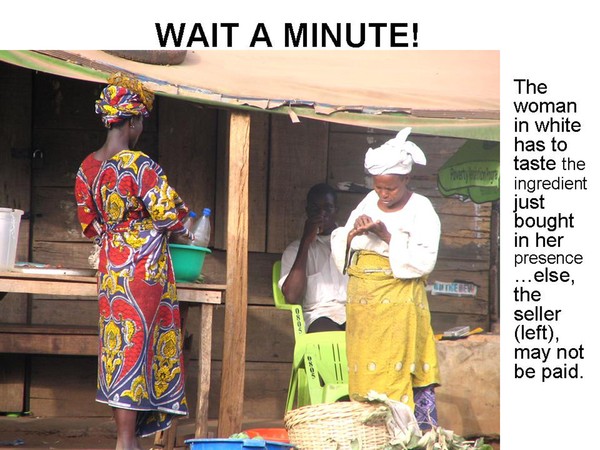- Adesina Adegbite
- View Portfolio
- Image 18 of 26
- Added 28 Aug 2007
- 279 Views
- 3 Comments
- Share This Image On...

THIS WORK IS MEANT TO CONDEMN THE ARCHAIC METHOD OF PROOF-TASTING QUALITY PRODUCT BY MY INDEGENEOUS PEASANTS....IN WEST-AFRICAN CONTINENT.THIS AHS TO STOP!
3 Comments
Anonymous Guest 19 Jan 2025
Analysis of the Image: "WAIT A MINUTE!" by Adesina Adegbite This photograph provides a powerful commentary on cultural practices in some parts of West Africa, particularly focusing on consumer trust. The scene depicts a woman in white, presumably a buyer, tasting the product in the presence of the seller before finalizing the payment. The act of tasting signifies an archaic method used to ensure product quality and prevent disputes in trade. The visual composition emphasizes rural or traditional settings with wooden structures and simple attire, suggesting the scene unfolds in a local marketplace. The vibrant outfit of the seller reflects cultural identity and tradition, while the buyer’s focused stance indicates the gravity of the interaction. The text accompanying the image strongly criticizes this practice, describing it as demeaning and outdated. By highlighting this, the artist advocates for modernization in trade systems and emphasizes the need for respect and trust between buyers and sellers. Adegbite’s work is a critique of societal norms that persist in rural settings and an appeal for dignity in daily interactions. The photograph not only captures an everyday event but transforms it into a call for change. This visual commentary provokes thought on the intersection of tradition and progress in West AfricanAnonymous Guest 15 Jan 2025
This image illustrates a marketplace scenario common in parts of West Africa, where a seller and buyer are engaged in a traditional transaction process. The caption criticizes the practice depicted, where a buyer is seen tasting or verifying the quality of a product before completing the purchase. The seller, dressed in vibrant traditional attire and standing behind a table with goods, appears to be observing the buyer, who is holding or inspecting an item. The scene reflects a long-standing cultural norm rooted in trust-building and quality assurance, especially in rural and local markets. This method of "proof-tasting" ensures that the buyer receives satisfactory goods and prevents disputes about product quality. While the caption labels the practice as archaic, it underscores the persistence of indigenous traditions in modern times, hinting at the tension between contemporary commerce practices and older, community-driven approaches. The clothing style, consisting of colorful African prints and headwraps, highlights the cultural identity of the individuals and the informal, communal nature of the market. The surroundings, including wooden stalls and simple furniture, reinforce the setting as a typical rural or semi-urban marketplace. The message in the image calls for a shift away from this method, suggesting it might undermine the dignity of sellers and reflects outdated customs. However, it also raises questions about modernization and the importance of preserving cultural practices. While modern retail standards favor pre-packaged and branded goods, such traditional methods emphasize interpersonal trust and direct engagement between buyer and seller. In conclusion, the image and its message draw attention to the intersection of tradition and modernization, urging a re-evaluation of certain cultural norms without dismissing their historical significance.Anonymous Guest 15 Jan 2025
This image illustrates a marketplace scenario common in parts of West Africa, where a seller and buyer are engaged in a traditional transaction process. The caption criticizes the practice depicted, where a buyer is seen tasting or verifying the quality of a product before completing the purchase. The seller, dressed in vibrant traditional attire and standing behind a table with goods, appears to be observing the buyer, who is holding or inspecting an item. The scene reflects a long-standing cultural norm rooted in trust-building and quality assurance, especially in rural and local markets. This method of "proof-tasting" ensures that the buyer receives satisfactory goods and prevents disputes about product quality. While the caption labels the practice as archaic, it underscores the persistence of indigenous traditions in modern times, hinting at the tension between contemporary commerce practices and older, community-driven approaches. The clothing style, consisting of colorful African prints and headwraps, highlights the cultural identity of the individuals and the informal, communal nature of the market. The surroundings, including wooden stalls and simple furniture, reinforce the setting as a typical rural or semi-urban marketplace. The message in the image calls for a shift away from this method, suggesting it might undermine the dignity of sellers and reflects outdated customs. However, it also raises questions about modernization and the importance of preserving cultural practices. While modern retail standards favor pre-packaged and branded goods, such traditional methods emphasize interpersonal trust and direct engagement between buyer and seller. In conclusion, the image and its message draw attention to the intersection of tradition and modernization, urging a re-evaluation of certain cultural norms without dismissing their historical significance.